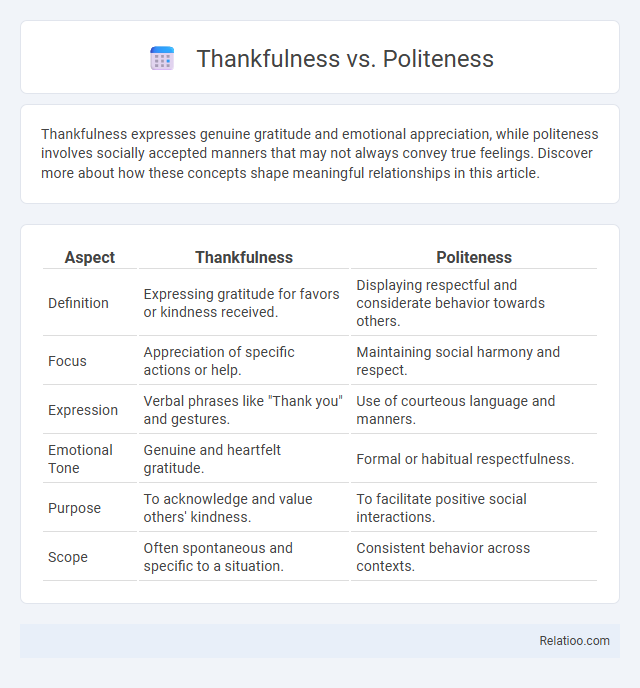Thankfulness expresses genuine gratitude and emotional appreciation, while politeness involves socially accepted manners that may not always convey true feelings. Discover more about how these concepts shape meaningful relationships in this article.
Table of Comparison
| Aspect | Thankfulness | Politeness |
|---|---|---|
| Definition | Expressing gratitude for favors or kindness received. | Displaying respectful and considerate behavior towards others. |
| Focus | Appreciation of specific actions or help. | Maintaining social harmony and respect. |
| Expression | Verbal phrases like "Thank you" and gestures. | Use of courteous language and manners. |
| Emotional Tone | Genuine and heartfelt gratitude. | Formal or habitual respectfulness. |
| Purpose | To acknowledge and value others' kindness. | To facilitate positive social interactions. |
| Scope | Often spontaneous and specific to a situation. | Consistent behavior across contexts. |
Understanding Thankfulness: Definition and Depth
Thankfulness is a profound emotional state expressing genuine gratitude for kindness or benefits received, going beyond mere social etiquette. Your acknowledgement of thankfulness reflects an internal appreciation that fosters deeper human connections and personal fulfillment. Unlike politeness and courteousness, which are often habitual or situational behaviors, thankfulness embodies sincere recognition and emotional warmth.
What Constitutes Politeness in Society
Politeness in society involves using respectful language, attentive listening, and considerate behavior to maintain social harmony and show regard for others' feelings. It requires understanding cultural norms and situational contexts, ensuring your actions and words align with expected standards of decorum. Practicing politeness helps you build positive relationships and fosters mutual respect in both personal and professional environments.
Emotional Origins: Gratitude vs. Social Etiquette
Thankfulness stems from genuine gratitude, an emotional response to kindness or favor that enriches your personal well-being and fosters positive relationships. Politeness arises from social etiquette, a learned behavior aimed at maintaining harmony and respect in interpersonal interactions. Courteousness blends these by expressing respect and consideration, influenced both by internal gratitude and external social norms.
The Role of Intent: Genuine Feelings or Social Obligation
Thankfulness arises from genuine feelings of gratitude, reflecting your sincere appreciation for kindness or help received. Politeness often serves as a social obligation, guiding behavior to conform to societal norms without necessarily involving true emotion. Courteousness balances both intent and formality by expressing respect and consideration, regardless of whether your feelings are deeply felt or socially expected.
Impact on Personal Relationships
Thankfulness strengthens personal relationships by expressing genuine gratitude, fostering trust, and encouraging positive interactions. Politeness creates a respectful environment, allowing smooth communication and minimizing conflicts. Courteousness enhances social harmony by demonstrating consideration and kindness, making your interactions more meaningful and lasting.
Cultural Interpretations of Thankfulness and Politeness
Thankfulness, politeness, and courteousness vary significantly across cultures, shaping social interactions and expressions of respect. In many Asian cultures, politeness emphasizes indirect communication and humility, while Western cultures often prioritize explicit verbal thankfulness as a social norm. Your understanding of these cultural nuances enhances effective communication and fosters mutual respect in diverse settings.
Thankfulness in Communication: Words and Actions
Thankfulness in communication involves expressing genuine gratitude through words and actions that acknowledge the efforts or kindness of others, enhancing interpersonal connections and trust. Your sincere thank-you notes, timely acknowledgments, and heartfelt compliments contribute significantly to positive social interactions and emotional well-being. Unlike politeness and courteousness, which emphasize social norms and etiquette, thankfulness conveys a deeper emotional appreciation that fosters meaningful relationships.
Politeness Strategies Across Different Contexts
Politeness strategies vary significantly across different cultural and social contexts, influencing how individuals express respect, deference, or social distance. You can observe direct versus indirect speech acts, honorifics, and non-verbal cues employed strategically to maintain harmony and avoid face-threatening acts. Understanding these nuanced politeness strategies enhances effective communication by adapting behavior appropriately to formal, informal, or intercultural settings.
Long-term Benefits: Lasting Effects of Gratitude vs. Courtesy
Thankfulness fosters deep emotional connections and enhances mental well-being, contributing to long-term happiness and resilience. Politeness and courteousness create positive social interactions and promote respect, building a foundation for strong, enduring relationships. Your consistent expression of gratitude can cultivate lasting goodwill and trust, surpassing the more formal and situational effects of courtesy.
Cultivating Thankfulness and Politeness in Daily Life
Cultivating thankfulness involves recognizing and appreciating the positive aspects and kindnesses encountered daily, fostering a mindset of gratitude that enhances emotional well-being. Politeness emphasizes respectful communication and considerate behavior, which helps build harmonious social interactions and mutual respect. Integrating both thankfulness and politeness in daily life promotes positive relationships and a supportive community environment.

Infographic: Thankfulness vs Politeness
 relatioo.com
relatioo.com